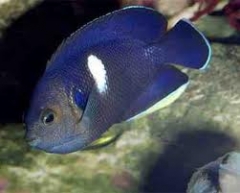Search the Community
Showing results for tags 'keyhole angelfish'.
-

Keyhole Angelfish ( Centropyge tibicen )
Harlequinmania posted a gallery image in Dwarf Angelfish (Centropyge)
Scientific Name : Centropyge tibicen Reef Compatible : With Caution Care Level : Intermediate Disposition : Semi-aggressive Min. Tank Size : 50 gallons Mature Size : 7.5 inches Diet : Omnivore Range : Indo-Pacific Other Common Names Tibicen Angelfish, Melas Angelfish Species Description Often overlooked because of it’s plain appearance, the Keyhole Angelfish is an excellent addition to a larger marine aquarium because of it’s usefulness at eating filamentous algae and diatoms growing on the decorations and rockwork. This dwarf Angelfish is one of the largest of the Centropyge (7.5”) and can become quite aggressive toward other pygmy angelfish which are not introduced at the same time. This is one of those Centropyge Angelfish which must be kept in an aquarium utilizing live rock for filtration or decoration. They have been observed picking at stony and soft corals as well as clam mantles but we have had individuals live happily in full reef tanks for years with no problems. Keep an eye on the fish if you have coral and adjust its diet if you notice it bothering sessile invertebrates. It will not harm or even notice non-sessile invertebrates such as shrimp or crabs. Diet In the wild the Keyhole angelfish has a varied diet consisting of algae and crustaceans. The Keyhole angel is not considered reef safe as it may nip at large polyped stony corals, soft corals, zoanthids and clam mantles. There are occasional specimens that live very long lives in reef aquaria as peaceful citizens but the majority of these fish will often turn for no apparent reason when they are older. This may be easily explained as many of the Centropyge family are predominately plankton eaters as juveniles and will switch to consuming it’s natural adult diet once fully grown. Sometimes all it takes is for an underfed individual to ‘test’ a food source. This being the case, be sure to add this specimen to a well established tank and feed frozen mysis shrimp, meaty crustaceans such as shrimp and clam. Be sure to include algae such as spirulina.

